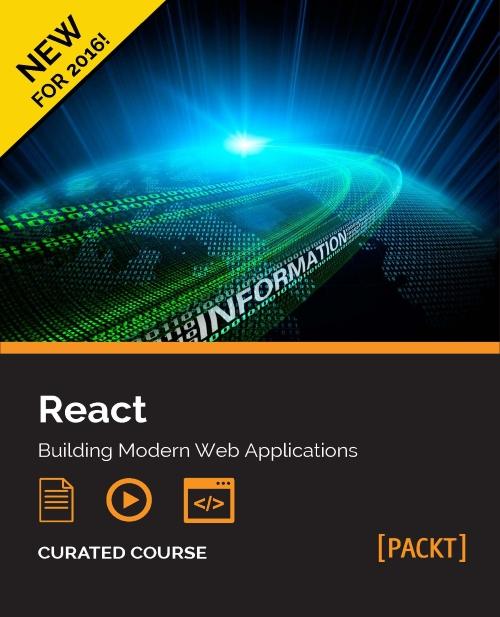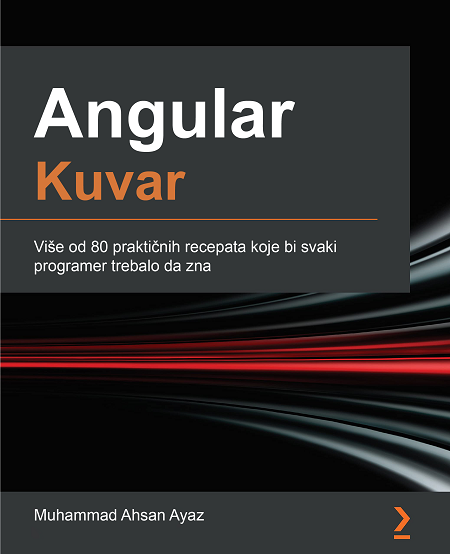
Autor: Jonathan Hayward et al.
Broj strana: 910
ISBN broj: 9781786462268
Izdavač:
PACKT PUBLISHING ![]()
Godina izdanja: 2016.
 |
 |
 |
 |
 |
||||
ReactJS has helped to transform the web as we know it. Designed by Facebook to help developers build rapid, responsive UI that can deal with data-intensive usage, it’s an essential component in any web developer’s skillset. This ReactJS course, in five connected modules, provides you with a fast, engaging and practical route into ReactJS—so you can build powerful, elegant, and modern web applications.
Beginning with the Reactive Programming with JavaScript module, you will learn how to take advantage of a reactive and functional programming paradigm to rethink how you approach your JavaScript code. It’s built to help you understand the concepts, relevant and applicable for any frontend developer.
You’ll then dive a little deeper into ReactJS. The second module gives you a rapid look through the fundamentals of ReactJS, showing you how to build a basic application and demonstrating how to implement the Flux architecture.
In the third module you will get to grips with ES6—this will make you a more fluent JavaScript developer, giving you control over ReactJS. You can put your old JavaScript hacks aside and instead explore how to create ES6 custom iterators.
In the final two modules you’ll learn how to fully master ReactJS, exploring its wider ecosystem of tools that have helped to make it one of the most important tools in web development today. Ending with insights and guidance on React Native, the tool built for today’s demand for native, intuitive user experiences and interfaces, with this course you can be confident in building dynamic and modern apps with React.
Jonathan Hayward is a polymath with advanced degrees bridging mathematics, computers (UIUC), theology, and philosophy. He obtained his theology and philosophy degrees from Cambridge University. He has worked in many areas of web development, with a site (http://cjsh.name/) for "after hours" titles, and he is also interested in the human side of computing, including usability/UI/UX. His most popular work is a piece of poetry at https://cjshayward.com/doxology/. The faster route to get there is by typing cjsh.name/doxology, and it gets there. Jonathan has studied many languages, including French, Spanish, Latin, and Greek. He is currently learning Russian. He has worked on various other books as well (refer to http://www.amazon.com/s/ref=nb_sb_noss_2?url=searchalias%3Daps&field-keywords=%22CJS+Hayward%22 to find out more).
Artemij Fedosejev is a technical lead living in London, United Kingdom. He is a self-taught web developer who has been a web developer since the early 2000s. Artemij earned his BSc in computer science from University College Cork, Ireland. He participated in the IGNITE Graduate Business Innovation Programme, where he built and launched a website that received the Most Innovative Project award.
After graduation, Artemij moved to London to help local start-up companies build their products. He worked with JavaScript, Node.js, HTML5, CSS3, and other modern web technologies. After gaining some experience in the start-up industry, Artemij was presented with an opportunity to join Imperial College, London, work on a research and development, project and take leadership in creating frontends for a couple of web applications in the public health space. He played a key role in creating frontend architecture using React.js and Flux for WGSA.net and Microreact. org. Artemij created a number of open source projects such as Snapkite Engine, Snapkite Stream Client, and other projects, which can be found on his GitHub account at https://github.com/fedosejev. He is also the author of the http://react.tips website.
Narayan Prusty is a web and mobile app developer. He specializes in WordPress, HTML5, JavaScript, PHP, Solr, and Cordova. He has been learning and building applications using these technologies for many years. He is the founder of QScutter.com, which provides courses on various application development topics and has more than 10,000 subscribers worldwide. His personal blog, http://www.QNimate.com, is among the top Intel XDK and WordPress blogs. He also works as a consultant and freelance developer for many companies worldwide. He is also the author of Learning ECMAScript 6, Packt Publishing. You can visit him online at http://www.twitter.com/narayanprusty.
Adam Horton is an avid retro gamer as well as a creator, destroyer, and rebuilder of all things Web, computing, and gaming. He started his career as a firmware developer for the high-end Superdome server division at Hewlett Packard. There, the JavaScript and C he wrought directed the power, cooling, health, and configuration of those behemoth devices. Since then, he has been a web developer for PayPal, utilizing cross-domain JavaScript techniques with an emphasis on user identity. Lately, at ESO Solutions, he's a lead JavaScript developer for next-generation, prehospital electronic health record (EHR) field collection applications.
Adam believes in an inclusive, ubiquitous, and open Web. He values pragmatism and practice over dogma in the design and implementation of computing applications and education.
Ryan Vice is the founder and chief architect of Vice Software, which specializes in practical, tailored solutions for clients, whether they are looking to get their MVP to market or modernize existing applications. On top of offering more competitive prices across the board, Vice Software offers skill-based pricing, which means you only pay architect rates when needed and pay much lower production rates for simpler feature work. Ryan has also been awarded Microsoft's MVP award three times, has published one other book on software architecture, and frequently speaks at conferences and events in Texas. Additionally, Ryan is lucky enough to be married to his wife, Heather, and spends most of his free time trying to keep up with their three kids, Grace, Dylan, and Noah.
Ethan Holmes is a Software Engineer from Vancouver, BC, Canada. He obtained a B.Sc. in computer science from Simon Fraser University. He has primarily been a full-stack web developer working and creating applications for start-ups in the Silicon Beach area. Currently, he is stationed at Cargomatic, disrupting the freight industry. After learning React for the web, learning React Native complemented the skills he obtained as a web developer and allowed him to quickly make the transition to mobile development.
You can follow him on Twitter at @sherclockholmes.
Tom Bray has been developing for the web since the browser wars of the late 90s when DHTML was the buzzword of the day. Creating great user experiences using the cutting edge technologies of the day has always been his passion, from Flash to Flex to Adobe AIR to React, and React Native.
He has created sophisticated software that has been used by large companies, such as Adobe, MySpace, Cisco, Informatica, and Dell; it has been a key contributor to numerous start-ups where he has worn many hats and gained a broad skill set. He currently serves as the Principal Software Architect with Cargomatic where he has designed a system to orchestrate the movement of ocean freight to and from America's ports—a solution that leveraged React Native to assign work to truck drivers and track their progress.
You can follow him on Twitter at @tombray.
• Mladen
Matoro je to danas je 2019 g a sjutra 2020 g.
• Aleksandra
Zainteresovana sam za ovu knjigu. Nadam se da ce biti uskoro prevedena

Popust cena:
2370.00 rsd

Popust cena:
1320.00 rsd
© Sva prava pridržana, Kompjuter biblioteka, Beograd, Obalskih radnika 4a, Telefon: +381 11 252 0 272 |
||